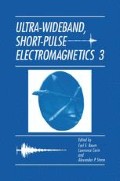Abstract
In radar cross section applications, it is well known that the electromagnetic backscattering from a complex target can be approximately modeled as if it is emanating from a discrete set of points on the target called scattering centers. The scattering center model, while only an approximation, is conceptually simple and provides a sparse abstraction of the actual target for numerous radar applications. For instance, by storing the strength and position of the scattering centers, the 1D range profile and 2D inverse synthetic aperture radar (ISAR) imagery of the target can be easily reconstructed in real time, alleviating the need for the storage of large data sets. Therefore, the extraction of the scattering center model of a target from electromagnetic signature data is an important problem1.
Access this chapter
Tax calculation will be finalised at checkout
Purchases are for personal use only
Preview
Unable to display preview. Download preview PDF.
References
R. Bhalla and H. Ling, “3D scattering center extraction using the shooting and bouncing ray technique,” to appear in IEEE Trans. Antennas Propagat.,1996.
L. Cohen, Time-Frequency Analysis, Prentice Hall, Englewood Cliffs, NJ, 1995.
S. Qian and D. Chen, Introduction to Joint Time-Frequency Analysis - Methods and Applications. Prentice Hall, Englewood Cliffs, NJ, 1996.
K. F. Casey, D. G. Dudley, and M. R. Portnoff, “Radiation and dispersion effects from frequency-modulated (FM) sources, ” Electromagnetics, vol. 10, pp. 349–376, 1990.
A. Moghaddar and E. K. Walton, “Time-frequency-distribution analysis of scattering from waveguide cavities,” IEEE Trans. Antennas Propagat., vol. 41, pp. 677–680, May 1993.
H. Kim and H. Ling, “Wavelet analysis of radar echo from finite-size targets,” IEEE Trans. Antennas Propagat., vol. AP-41, pp. 200–207, Feb. 1993.
H. Ling, J. Moore, D. Bouche and V. Saavedra, “Time-frequency analysis of backscattered data from a coated strip with a gap,” IEEE Trans. Antennas Propagat., vol. 41, pp. 1147–1150, Aug. 1993.
L. Carin and L. B. Felsen, “Wave-oriented data processing for frequency-and time-domain scattering by nonuniform truncated arrays,” IEEE Antennas Propagat. Mag., vol. 36, pp. 29–43, June 1994.
J. Moore and H. Ling, “Super-resolved time-frequency analysis of wideband backscattered data, ” IEEE Trans. Antennas Propagat., vol. 43, pp. 623–626, June 1995.
L. C. Trintinalia and H. Ling, “Interpretation of scattering phenomenology in slotted waveguide structures via time-frequency processing,” IEEE Trans. Antennas Propagat., vol. 43, pp. 12531261, Nov. 1995.
S. Qian and D. Chen, “Signal representation using adaptive normalized Gaussian functions,” Signal Processing, vol. 36, no. 1, pp. 1–11, Mar. 1994.
S. G. Mallat and Z. Zhang, “Matching pursuits with time-frequency dictionaries,” IEEE Trans. Signal Processing, vol. 41, pp. 3397–3415, Dec. 1993.
H. T. G. Wang, M. L. Sanders and A. Woo, “Radar cross section measurement data of the VFY 218 configuration,” Tech. Rept. NAWCWPNS TM-7621, Naval Air Warfare Center, China Lake, CA, Jan. 1994.
D. J. Andersh, M. Hazlett, S. W. Lee, D. D. Reeves, D. P. Sullivan and Y. Chu, “Xpatch: A high-frequency electromagnetic scattering prediction code and environment for complex three-dimensional objects,” IEEE Antennas Propagat. Mag., vol. 36, pp. 65–69, Feb. 1994.
Author information
Authors and Affiliations
Editor information
Editors and Affiliations
Rights and permissions
Copyright information
© 1997 Springer Science+Business Media New York
About this chapter
Cite this chapter
Trintinalia, L.C., Ling, H. (1997). Feature Extraction from Electromagnetic Backscattered Data Using Joint Time-Frequency Processing. In: Baum, C.E., Carin, L., Stone, A.P. (eds) Ultra-Wideband, Short-Pulse Electromagnetics 3. Springer, Boston, MA. https://doi.org/10.1007/978-1-4757-6896-1_36
Download citation
DOI: https://doi.org/10.1007/978-1-4757-6896-1_36
Publisher Name: Springer, Boston, MA
Print ISBN: 978-1-4419-3276-1
Online ISBN: 978-1-4757-6896-1
eBook Packages: Springer Book Archive

